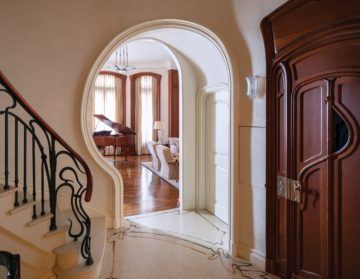Burkhard Bilger in The New York Times:
 Mark Ellison stood on the raw plywood floor, staring up into the gutted nineteenth-century town house. Above him, joists, beams, and electrical conduits crisscrossed in the half-light like a demented spider’s web. He still wasn’t sure how to build this thing. According to the architect’s plans, this room was to be the master bath—a cocoon of curving plaster shimmering with pinprick lights. But the ceiling made no sense. One half of it was a barrel vault, like the inside of a Roman basilica; the other half was a groin vault, like the nave of a cathedral. On paper, the rounded curves of one vault flowed smoothly into the elliptical curves of the other. But getting them to do so in three dimensions was a nightmare. “I showed the drawings to the bass player in my band,” Ellison said. “He’s a physicist, so I asked him, ‘Could you do the calculus for this?’ He said, ‘No.’ ”
Mark Ellison stood on the raw plywood floor, staring up into the gutted nineteenth-century town house. Above him, joists, beams, and electrical conduits crisscrossed in the half-light like a demented spider’s web. He still wasn’t sure how to build this thing. According to the architect’s plans, this room was to be the master bath—a cocoon of curving plaster shimmering with pinprick lights. But the ceiling made no sense. One half of it was a barrel vault, like the inside of a Roman basilica; the other half was a groin vault, like the nave of a cathedral. On paper, the rounded curves of one vault flowed smoothly into the elliptical curves of the other. But getting them to do so in three dimensions was a nightmare. “I showed the drawings to the bass player in my band,” Ellison said. “He’s a physicist, so I asked him, ‘Could you do the calculus for this?’ He said, ‘No.’ ”
Straight lines are easy, curves are hard. Most houses are just collections of boxes, Ellison says. We stack them side by side or on top of one another, like toddlers playing with blocks. Add a triangular roof and it’s done. When buildings were still made by hand, the process would yield the occasional curve—igloos, mud huts, wigwams, yurts—and master builders earned their keep with arches and domes. But flat shapes are cheaper to mass-produce, and every sawmill and factory spits them out in uniform sizes: bricks, boards, drywall, tile. It’s the tyranny of the orthogonal, Ellison says.
“I can’t do the calculus on this, either,” he added, shrugging. “But I can build it.” Ellison is a carpenter—the best carpenter in New York, by some accounts, though that hardly covers it. Depending on the job, Ellison is also a welder, a sculptor, a contractor, a cabinetmaker, an inventor, and an industrial designer. He’s a carpenter the way Filippo Brunelleschi, the architect of the great dome of the Florence Cathedral, was an engineer. He’s a man who gets hired to build impossible things.
More here. (Note: For Jaffer Kolb, the best architect I know)
